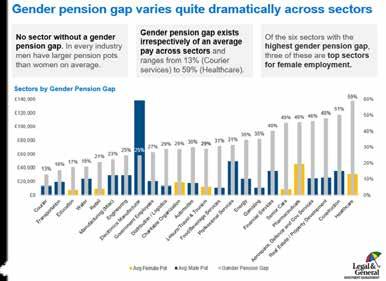

CEO’s Viewpoint
Welcome to the autumn edition of Viewpoint, which falls shortly before the curtain rises on our biggest show of the year, our flagship Annual Conference in Liverpool, on 12-13 October.
It has been a tough year for many reasons. The war in Ukraine, the continuing reverberations of the Covid-19 pandemic, and of course, the death of HM Queen Elizabeth II. Everyone at the PLSA has been deeply saddened by her passing, and we joined the nation in mourning a remarkable life of service, sacrifice and devotion. Our heartfelt sympathies are with the Royal Family. This year has also seen the cost of living crisis bite for millions of people up and down the UK, and as we head into the winter, the pain is only likely to get worse. This is a huge concern for all of us. For those of us working in pensions and finance, it’s vital that we discuss what we can do as an industry to help. This will be one of the main themes at conference, looking at today’s challenges and tomorrow’s solutions, and one I’m sure many of you will be keen to join the debate on.
We’ll hear from some famous names – Fiona Bruce, Clive Myrie, Nick Robinson and Claer Barrett. And we’ll

explore an array of issues from the different perspectives of schemes, local authorities, providers, advisers and other industry stakeholders. The pressures affect everyone and our conference is a great platform to bring all types of PLSA member together so that we can look at the challenges holistically and from every angle.
Conference will culminate in the launch of our new report looking at how, as a pensions industry, we can ensure we have a pensions framework that enables everyone to have an adequate income in retirement, with a specific focus on expanding the scope and level of automatic enrolment. This is our vision, and we look forward to sharing more detail with you at conference.
#PENSIONATTENTION
Helping the public to engage with and better understand their finances is the other side of the same coin, and in particular asking people to pay their pension some attention. Sound familiar? You may have heard or seen Grime artist and TV cook Big Zuu – on radio, billboards, TV and social media – telling the nation just that.
Big Zuu has produced a new track and accompanying video encouraging listeners to ask questions, make connections and think about future intentions, offering a refreshing and catchy take on pensions to show they are relevant to everyone. It’s part of a crossindustry pension engagement campaign, coordinated by the PLSA and ABI, and we’re proud to have Big Zuu on board. To find out more read on for the full article in this issue of Viewpoint, and if you’re attending conference there will be a session on the campaign.
CONFERENCE HAT TRICK
After two long years, this spring we were finally able to run Investment and Local Authority Conferences in person, and with Liverpool almost upon us we’re about to make it a hat-trick. It will be our first in-person Annual Conference

since 2019, and we’re excited to bring the pensions industry together again.
Your support throughout lockdown while our events were digital, and this year during our return to face-to-face, has been invaluable. Thank you. As we’ve transitioned back to face-to-face events, we’ve taken the opportunity to review how we do certain things, making sure the conferences continue to appeal to members and deliver value. We’ve introduced new session formats and additional networking events, which should appeal to a wide range of roles. We hope that you’ll be able to make it to Liverpool this October, but if you are unable to join us there will be plenty of content on our website, social media and of course, Viewpoint magazine. See you again in person, or in print, very soon.
Best wishes, Julian Mund
IT WILL BE OUR FIRST INPERSON ANNUAL CONFERENCE SINCE 2019, AND WE’RE EXCITED TO BRING THE PENSIONS INDUSTRY TOGETHER AGAIN

Ecological sense never made more nancial sense.

































Our planet is under threat from complex, interlinked challenges – climate change and biodiversity loss. Both pose major risks to businesses, while adopting nature-positive investments can o er opportunity.
Invest in the companies leading the transition to a more sustainable world. Because taking action now could mean a better future for people and our planet.
Investment involves risk including loss of capital. Be invested in better, now.




This promotional communication does not constitute an o er to buy or sell any investments, products or services and should not be considered as a solicitation, or as investment, legal or tax advice. This material does not contain su icient information to support an investment decision. Issued in the UK by AXA Investment Managers UK Limited, which is authorised and regulated by the Financial Conduct Authority in the UK. Registered in England and Wales, No: 01431068. Registered O ice: 22 Bishopsgate, London, EC2N 4BQ. In other jurisdictions, issued by AXA Investment Managers SA’s a iliates in those countries. © AXA Investment Managers 2022. All rights reserved.

Today’s challenges, tomorrow’s solutions
The PLSA’s Annual Conference is returning as an in-person face-to-face event for the first time in three years, at ACC Liverpool from 12-13 October. It’s the perfect place for delegates to join policy drivers, disruptors, engagers and thought leaders to discuss today’s challenges and tomorrow’s solutions.
TODAY’S CHALLENGES






This year’s conference takes a look at how people can continue to save enough for retirement as day-to-day costs spiral.
It will also delve into schemes’ latest investment priorities in an era of active stewardship and ESG. How can we ensure the regulatory environment works for all schemes, and has enough flexibility for defined benefit?

In a period of intense market volatility, journalist Nick Robinson will join PLSA Chair Emma Douglas to explore potential outcomes for the government, the economy, and our citizens.



We also bring together policymakers and industry leaders, chaired by journalist and presenter Fiona Bruce, to discuss key topical issues facing pensions. This far-reaching debate looks at challenges from engaging members with long-term savings in the midst of a cost-of-living crisis, to environmental protection in investment strategies.

TOMORROW’S SOLUTIONS


Schemes are due to start connecting to the Pensions Dashboards ecosystem in 2023, so our session giving the latest updates on this vital initiative, as well as our drop-in question session, are bound to prove popular. Other DC scheme priorities, including small pots management, drawdown trends and retirement planning, are also on our programme over the two days.
For DB schemes, endgame planning, the new DB Funding Code, and investment in an incredibly volatile environment are all priorities addressed in our sessions. Come and hear David Fairs of The Pensions Regulator discuss what schemes can expect from TPR’s new Code, and join a range of pension scheme leaders including Bill Galvin, CEO of
MORE THAN ANYTHING, WE’RE LOOKING FORWARD TO SEEING EVERYONE BACK TOGETHER AGAIN
USS, to discuss future investment, governance and administration trends.

It’s a full-on two-day schedule and one that is sure to leave something to think about with everyone who attends when they return to their workplaces. More than anything, we’re looking forward to seeing everyone back together again. This conference gives us the opportunity to strengthen existing relationships while also forging new ones.
Through our continued work as an industry, and by sharing new ideas and ways of working, we can help to ensure that the millions of people saving into workplace pensions can achieve a better income in retirement.
Be part of the debate at the biggest pensions conference of the year. For more information about the conference visit www.plsa.co.uk.
Get ready for
A campaign led by
The Pension Attention campaign is a co-ordinated industry campaign led by the Association of British Insurers (ABI) and the Pensions and Lifetime Savings Association (PLSA) to boost people’s understanding and engagement with their pension.
What are we aiming for?
Make sure you follow us and use #PensionAttention
The campaign aims to bring the industry together around a common message aimed at breaking through the public’s lack of interest and making pensions a talking point for people going about their everyday lives.
the campaiGn on all Social platformS
Give your pension some attention!
Get behind our new campaign, urges Deputy Director of Policy Joe Dabrowski

More people are saving into a workplace pension than ever before, but despite previous efforts by the industry, government and money guidance bodies, engagement with pensions is still low. Over half the public struggle to find their pension information and only 20% are confident they are saving enough for retirement.
Against that backdrop, now is the time to try something new and bold to reach the unengaged, to break through the public’s lack of interest and make pensions a talking point. Given the cost-of-living pressures being experienced by many, it is more important now than ever that people making difficult decisions do so from a position of knowledge.
The PLSA and the Association of British Insurers (ABI) are proud to have launched a nationwide saver engagement campaign, uniting the industry behind a single message, urging savers to ‘Pay Your Pension Some Attention.’ Running from Pensions Awareness Week in September through to Talk Money Week in November, the success of the Pension Attention campaign hinges on a collaborative effort from across the industry to raise the volume and make some noise about the power of pensions.
With support from some of the bestknown brands in the pensions industry, we want to reach people we don’t normally reach and empower them to understand what pension savings they have, how easy it is to keep track of, and how powerful pension saving is in giving people choice and freedom when they retire.
That’s why we went to an unexpected source and challenged them to produce a new track and accompanying video.
Grime artist and Bafta award-winning TV personality Big Zuu’s lyrics encourage listeners to ‘ask questions’, ‘make connections’ and think about ‘future intentions.’ We hope it offers a refreshing and catchy take on pensions to show they are relevant to everyone.
The attention-grabbing song directs people to Pensionattention.co.uk for basic information on how pensions work, including how everything you save gets a boost from your employer and the taxman too. There’s also help with tasks such as tracking down forgotten pensions from previous jobs.
We know the track will not be to everyone’s musical tastes, but we expect it to have the power to generate conversations in the home and among friends and family. Zuu has recently started his own pensions engagement journey, tracking down pots from early jobs as a teenager in retail and hospitality, so he understands what people need to do to pick up the basics.
As people face difficult financial choices this autumn, it is more important than ever that they have confidence in their workplace pension and understand how to keep track of it. Pensions are not only for times of prosperity, and there will always be people dealing with difficult financial circumstances.
This is not about asking people to contribute more, but about helping savers reconnect with their pensions and to feel good about having retirement savings.
Pension providers have planned lots of activity through the campaign season. Some have built dedicated landing pages to support campaign messages and encourage their members to log in and make sure their details are up to date. Others have published top tips articles to
AS PEOPLE FACE DIFFICULT FINANCIAL CHOICES THIS AUTUMN, IT IS MORE IMPORTANT THAN EVER THAT THEY HAVE CONFIDENCE IN THEIR WORKPLACE PENSION AND UNDERSTAND HOW TO KEEP TRACK OF IT
tell savers the easiest ways to pay their pension some attention. We’ve even seen the campaign logo on annual benefit statements, member communications and newspaper advertisements.
We encourage pension providers of all shapes and sizes to get behind the campaign in whatever way they can: from sharing campaign materials on social media to taking a selfie in front of one of the digital billboards we’ll be running at train stations, there are any number of creative ways you can help.
Making pensions part of a wider conversation about lifestyle, and getting coverage beyond just the personal finance pages, requires us to make a big noise with something different. The industry has a great opportunity to change people’s perceptions that pensions are difficult or boring, and make a difference to people’s financial lives through better member engagement.
The decumulation minefield
What sort of guidance is out there to help savers access their pensions safely and securely at retirement? Ruari Grant, Policy Lead DC, Policy & Advocacy, reports.

As we all know, defined benefit (DB) pensions, and the financial security – even conplacency – they allow for, have been in decline for some time. Consequently, a replacement regime, introducing workers to saving into defined contribution (DC) schemes during their careers was needed – and together, government, industry and employers delivered that with auto-enrolment.
The industry splits pensions into two halves: accumulation (better understood as saving) and decumulation (not even a word, and so definitely better understood as spending). On this basis, autoenrolment has been no mean feat. Most people find spending easier than saving, so successfully bringing more than 10 million people into a workplace pension since 2015 is an achievement. Clearly there are caveats, and segments of the population are still under-saving, but the fundamental regime is in place.
Therefore, all that remains is the supposedly easier piece of the puzzle –how to get people to access (spend) their pension in a way that is both affordable and makes best use of it.
Except it’s not that easy. People reach retirement, and are suddenly confronted with a pot of money, and they’re expected to work out how to make it cover their spending (which will likely be unpredictable) for the rest of their life (the duration of which is – yes – also unpredictable).
Intended to cater for their needs, they have comlex products like annuities and drawdown to consider, alongside the ever-popular 25% tax-free cash… except depending on the type of pension
they have, some or all of these options may not even be available!
So the real challenge, as we see it, is helping people navigate this minefield, and we’ve been working with the Department for Work and Pensions throughout this year, including through its Call for Evidence, in an effort to bring about a framework that provides more reliable support for retirees.
EXISTING SUPPORT
What support currently exists, then? Currently, contract-based pension providers are required to offer default investment pathways for their customers,
which – as we discussed in our Call for Evidence submission – prevent a few bad outcomes, though fall short of the support we believe savers need. Financial advice is also a possibility, though will only be a reality for wealthier savers, while Pension Wise provides a valuable free guidance service – though to date, too few people make use of this.
But for savers in trust-based schemes, there is no requirement on trustees to provide any support at all, and due to the danger of the penalties for inadvertently crossing into what the Financial Conduct Authority terms ‘advice’, many actively avoid it.
PEOPLE REACH RETIREMENT, AND ARE SUDDENLY CONFRONTED WITH A POT OF MONEY, AND THEY’RE EXPECTED TO WORK OUT HOW TO MAKE IT COVER THEIR SPENDING FOR THE REST OF THEIR LIFE
UNDERSTANDING THE RISKS THEY FACE
TELLERS
Encouragingly, some of the large Master Trusts are now developing in-scheme retirement products and guidance. As we highlighted in our recent report on this area of the market, many of these are building innovative online member tools which aim to guide retirees through the key information and provide interactive opportunities to experiment with how they might allocate different proportions of their pension to different types of product. Over time, we expect more and more savers to pass through the accumulation state into these solutions which provide them with safe and secure guardrails for accessing their pension.
The conundrum, therefore, remains the many savers out there who are in a scheme which will not provide such inscheme support. According to the PLSA’s Guided Retirement Income Choices proposal, an obligation on trustees to support savers could include signposting provision, where members are effectively directed outside of their scheme to a trusted provider of retirement solutions which meets a set of agreed standards.
We acknowledge that capacity within existing Master Trusts and providers would need to develop quickly to accommodate such demand, but we believe this to be necessary. The Pensions Regulator expects DC assets to overtake DB assets in the next 15 years, and this means the number of people retiring who will be counting predominantly on
their DC savings to sustain them is only going one way. We will continue working with government, regulators and the industry over the coming months as we seek to build a regime for retirement that provides everyone with the support they need, whatever their understanding level, wealth or pension arrangement.
ENCOURAGINGLY, SOME OF THE
ARE NOW DEVELOPING IN-SCHEME
AND
Join the conversation
Join
monthly webinar



on

practical advice from






















of the latest trends





Fixed income: challenge or opportunity?
Arapid rise in interest rates in recent months has caused the worst performance of the UK gilt market since the early 1990s, which deepened in the aftermath of the September mini-budget.
This has created both major challenges and opportunities for trustees of closed defined benefit schemes.

It’s impossible to overstate just how significant the fixed income correction has been. Calum Mackenzie, investment partner at Aon, said before the miniBudget “The 2055 levered gilt LDI benchmark had fallen by 77% over 12 months, while Bitcoin fell by 50% over the same period.”
Guy Whitby-Smith, head of solutions portfolio management at LGIM, adds: “Both nominal and real interest rates have risen, which reversed changes that took place over eight to nine years.”
While there has been plenty of focus on the recent corrections in equity market, the more extreme changes in gilt markets even before the mini-Budget have largely been ignored. Mackenzie says: “The only equity market crash since 1980 which has been worse than the current UK long bond market crash was the credit crisis.”
Financial markets were already jittery about how the new Prime Minister would fund her plans to soften the blow of high energy costs, even before the mini-Budget. As a result, UK gilt yields had risen across the yield curve.
The rapid fall in fixed income valuations has created challenges for hedged closed DB schemes, which use interestrate swaps and gilt repos to provide this insurance. In effect, schemes are implementing unfunded hedging by using gilt repos, which allows them to invest more of the portfolio in growth assets.
The market correction, however, now means there is a marked-to-market loss on the scheme’s gilt repo assets, which creates significant demand for collateral.
This is akin to a negative equity situation with a home owner effectively needing to stump up the difference between the lower value of the property and the higher sum borrowed from the mortgage provider.
SCHEME RESPONSES
Investment consultants and LDI managers have been helping schemes to navigate these collateral calls in recent months.
Speaking before the mini-Budget, WhitbySmith says: “The majority of portfolios have weathered the market moves relatively robustly.” Given the size and
rapidity of the recent changes in fixed income, this shows the levels of leverage were manageable, he adds.
Elaine Torry, co-head of trustee DB investment at Hymans Robertson, says: “We have been very aware of the leverage associated with a scheme’s LDI portfolios, and that has helped us to navigate the difficulties of the last few months.”
Schemes which had the most leveraged LDI portfolios have been the most impacted by the recent market moves. Whitby-Smith says: “We have had one or two clients which have had to go through two rounds of topping-up collateral, but this has been the exception rather than the rule.”
There have been stories of difficult situations when trustees hadn’t taken the time to get familiar with the level of leverage in their portfolios and had been caught unaware, adds Torry.
FUTURE RISKS
Even if consultants and trustees have managed to weather the recent storm to date, they can’t afford to be complacent. There could be additional market corrections in coming months with rates rising and values falling further.
No country for old(er) women? Even female-dominated sectors witness gender pension gap





Regardless of where they’ve worked, women’s retirement savings are likely to be substantially less than those of men in similar roles. We look at the evidence, consider what might help address the imbalance, and confront the question of why it matters.
Counter-intuitive it may be, but even where female workers outnumber men, their pension pots are likely to be smaller than those of their male equivalents, according to research by Legal & General1
We already knew that men’s pension pots are generally worth around twice the amount of women’s at retirement – a disparity confirmed by Legal & General’s research into the gender pay gap from 2020 and our data from 2021. However, what may be surprising is that according to our latest findings, there doesn’t appear to be a single sector that bucks this trend – even in predominately female workforces.
for retirees was 54% as opposed to 56% in 2020. And while this small 2% close in the gap might not exactly be worthy of staging a parade, it may at least signal (as we hope it does) the start of a trend. However, even if the gap is starting to close, it remains significant and troubling.
Barriers to parity
Female pension savers face several barriers to achieving pot parity with men. Broadly, these tend to be the result of a combination of lower salaries and the disproportionate shouldering of domestic caring responsibilities which result in career breaks.
In 2021, we looked across our book of 4.5 million pension scheme members2 and found no sector without a gender pension gap. In fact, of the six sectors with the highest gaps (senior care; pharmaceuticals; aerospace, defence and government services; real estate and property development; construction; and healthcare), three are among the top sectors for female employment (senior care, pharmaceuticals and healthcare).
The only chink of light in our data for the future of the gender gap was in its suggested trajectory: in 2021 the gender pension gap
year) to be eligible to join a company pension plan4. Added to which, the cost of childcare can make it harder for women to take on work outside the home5
Other factors include divorce arrangements where women waive their rights to their former partner’s pension6, a lack of confidence in financial planning7, and the menopause – which is thought to be responsible for up to a million women having left employment to date because they’re struggling with its symptoms8
Rita Butler-Jone Co-Head of DC, LGIMWhile pension providers such as Legal & General can’t stop menopause or marital breakdowns, we can work with government, industry and employers to recognise where the risks are and investigate possible ways of mitigating them.
Tackling inequalities
At Legal & General, we set up a Pension Equalities Taskforce in 2021 to try to address inequalities in the pension system. The aims of the taskforce are to lobby government, regulators and trade bodies to establish priority actions, bring providers and industry representatives together to collaborate on research and representation, and work with employers to help find solutions. It also seeks to raise awareness and support members in their ability to make informed decisions about their retirement savings.
There may be no silver bullet to ending the gender pension gap, but unless we take a clear-eyed look at its underlying causes and take steps to address them, we believe women are likely to continue receiving significantly lower retirement incomes
This shouldn’t only matter to those women who may struggle to support themselves in later life. The issue will also affect the families, friends and publicly funded social care resources that these women may need to call on for help. In other words, it isn’t just a question of doing the right thing for women, it’s a question of doing the right thing for us all.
Frazer Morgan, head of UK hedging and derivatives portfolio management at WTW, says: “The issue is not just interest rates rising but the time taken to reach higher values.” For example, if interest rates were to increase to 10% over the next five years, schemes could take this in their stride. But rapid changes are much more challenging.
Mackenzie says that Aon had already begun asking its clients if they had stresstested their portfolio to have a strong enough collateral waerfall to maintain the hedge in more extreme circumstances.
Whitby-Smith adds: “We have been talking to our clients to prepare their portfolios for what might come.”
MOVING TARGET STRESS-TESTS
Schemes have been typically stress-testing their portfolios to see if they can handle 150 basis points across the yield curve. Mackenzie says: “This type of rate rise would usually be a one-in-20-year event.”
But in the year prior to the September mini-Budget there have been close to 200 basis point moves, with gilt yields moving as much as 20 basis points in a day. “This is an extreme situation,” adds Mackenzie.
This means pension schemes now need a moving target for their stress test, and they must clearly define which assets can be used in this eventuality, says Mackenzie.
Schemes need to do this analysis now because if their LDI manager makes a collateral call, it often needs to be paid in a week. Mackenzie says: “That does not allow enough time for a pension scheme to gets its trustee boards together, review the assets and decide which ones to use.”
Whitby-Smith says: “Each leg higher is going to be more challenging.” Schemes will need to replenish their collateral in preparation for increases in interest rates so they are not caught out, he adds.
Morgan says: “We’re helping clients to convert existing assets which aren’t collateral into collateral.” For example, this could involve turning an equity position into levered equity to release cash which can be used to make payments to LDI managers.
The lack of notice provided by the LDI managers in this rapidly changing marketplace creates a serious governance challenge. Normal pension scheme processes can’t match how rapidly these decisions need to be made.
“Last week an LDI manager wrote to a pension scheme saying it wanted the money in two weeks but markets moved more which meant the money was needed in a week,” says Mackenzie.
Kate Mijakowska, director of manager research at Redington, says: “We have pushed quite heavily for our clients to give power of attorney to the LDI manager for some assets to ensure these collateral requirements can be met.”
BEWARE INFLATION
Schemes also need to be vigilant about the impact of inflation. While liabilities become less sensitive to long-dated cost prices the closer these expectations are to the cap – as they are at the moment – this risk is still hard to manage.
Mijakowska says: “Inflation hedging needs to be dynamic as the sensitivity changes due to caps and floors, while the interest rate hedge can be more static.”
There has been considerable volatility in 20-year inflation pricing. Mijakowska says: “There was quite a sharp fall of 80 basis points from mid-March to the end of July, which was followed by a sharp increase of 75 basis points.”
This makes it difficult for schemes to rebalance their dynamic inflation hedges: this is a laborious process involving stakeholders and the scheme’s actuary, with the mandate then being handed over to the LDI manager.
Mijakowska says: “With this kind of volatility, by the time the decision has been made the markets may have moved again, negating the need to rebalance.”
To manage this well requires pension schemes to have good governance and to be vigilant.
OPPORTUNITIES?
But despite the challenges of managing an LDI strategy in the current environment, there are also opportunities. Despite high hedging levels, schemes have seen the benefits of interest rate rises on the value
of their liabilities, which has improved their ability to reach buy-out more rapidly.
James Brundrett, senior investment consultant at Mercer, says: “While clients might be close to fully hedged on technical provisions, they are probably underhedged on a buy-out basis.”
That’s because buy-outs value liabilities by using a gilt rate, whereas technical provisions also incorporate a discount rate based on future returns from growth assets. In other words, the buy-out valuations tend to be higher than those of technical provisions, so hedging levels are lower.
Brundrett says: “This means schemes have seen their buyout funding level improve which, in combination with increased yields on credit assets, has reduced the cost of a buy-out.” This is likely to result in a high volume of buy-out transactions over the next 12 months, he adds.
PLSA VIEW
Joe Dabrowski, Deputy Director of Policy, PLSA“Pension schemes are long-term investors and moments like this come from time to time. While this is a complex situation as there has been a lot of volatility in the gilt markets, we would not expect any significant issues for savers. In the immediate future we’d expect that higher gilt yields will improve scheme funding, which will mean that schemes – who are already well funded – will be in a stronger position.
“In the short-term there will be some operational challenges and pressures on liquidity. Whilst this is not ideal, they are challenges that can be overcome and the statement from the Bank of England is a helpful step to achieving that. As a next step it is important that the Bank of England engages with the pensions industry to put the £1.6trn liability driven investment market on a stable longterm footing.
Secure Income Assets | Securing member outcomes in an uncertain world
Pension investors are increasingly allocating to secure income assets due to the predictable, high-quality income these investments could deliver, whilst generating returns over and above what is achievable in public markets. Secure income assets could enhance diversification of portfolios in periods of uncertainty and provide quantifiable ESG benefits. As a specialist in secure income, Alpha Real Capital can guide you through this evolving space.
Explore secure income opportunities at the PLSA Annual Conference
Join us at the Trustee Learning Zone where Boris Mikhailov, Head of Client Solutions at Alpha Real Capital, will be unpacking secure income strategies.
Thursday 13 October, 10:05 – 10:50am, Room 3A, ACC Liverpool.
We will guide you in navigating the secure income space by providing an overview of the secure income universe and discussing how these assets could help you meet your objectives. In particular, we will focus on how secure income assets can provide resilient and inflation-linked cashflows, helping you to prioritise pensions in a stagflationary world.
About Alpha Real Capital
Alpha Real Capital is a specialist real assets investment manager focussed on secure income strategies. We invest in UK and European assets with predictable, secure, long-term cash flows.
We provide market leading and innovative real asset solutions across a range of investments - commercial ground rents, UK renewable infrastructure, social infrastructure, and secured lendingcombining operational real asset and credit expertise.


Alpha Real Capital is the largest commercial ground rents manager in the UK. We have a 160 plus strong professional team with £4.7bn AUM (including capital commitments), of which over £1bn is in social infrastructure. We manage £850mn in renewable energy assets and as a company we are certified carbon neutral.
SECURE INCOME ASSETS COULD ENHANCE DIVERSIFICATION OF PORTFOLIOS IN PERIODS OF UNCERTAINTY AND PROVIDE QUANTIFIABLE ESG BENEFITS
PENSION INVESTORS ARE INCREASINGLY ALLOCATING TO SECURE INCOME ASSETS DUE TO THE PREDICTABLE, HIGH-QUALITY INCOME THESE INVESTMENTS COULD DELIVER
Alpha Real Capital operates across diversified investment markets: listed and unlisted investment vehicles, open and closed ended property vehicles, UK and European funds, working with large institutional investors and wealth managers.
Visit our website www.alpharealcapital.com
Contact our Client Solutions team clientsolutions@alphareal capital.com
Follow us on LinkedIn https://www.linkedin.com/ company/alpha-real-capital/
Putting savers at the heart of all we do
Nicola Parish, Executive Director of Frontline Regulation, makes The Pensions Regulator’s priorities clear.
From taking action to tackle scammers to working to help ensure good value for money for savers – we continue to put savers at the heart of all we do.
The cost of living crisis is leaving savers potentially vulnerable to scammers as they may be lured by offers to access their pension savings early to cover essential household bills. Savers may also be attracted by fake investments offering high returns that never materialise.
To combat this, we will continue to improve the coordination of intelligence between scam-fighting partners to better disrupt and prevent fraud and scams and bring scammers to justice. We recently published our new scams strategy to help educate savers on the risk of scams, and we continue to drive up standards among trustees, so that scammers are stopped in their tracks.
Alongside our scam-fighting strategy, we also updated our automatic enrolment guidance for employers. The ongoing duties guidance calls on employers to encourage staff to seek help from MoneyHelper if they feel they may not be able to pay into their pension scheme due to the cost of living crisis. MoneyHelper is a government-backed impartial service savers should call before making any decisions. It is important people maintain their pension contributions if they are able to, as stopping contributions could have a serious impact on their retirement living standards.
NEW INVESTMENT GUIDANCE PUBLISHED
Robust monitoring of a scheme’s financial advisers can influence the effectiveness of its investment outcomes and ensure it is following long-term plans. It also helps trustees ensure they are delivering value for money for savers. In August, we published new guidance on the tender process for fiduciary management services and trustees setting objectives for their investment consultants.
Since December 2019, trustees have been legally required to run a competitive tender process when appointing fiduciary managers in relation to 20% or more of scheme assets. They have also been prohibited from receiving investment consultancy services without having set strategic objectives for their investment consultancy provider.
From 1 October, we will take over monitoring compliance with these requirements from the Competition and Markets Authority (CMA) following regulations made in August by the Department for Work and Pensions.
SMALL SCHEMES URGED TO PROVIDE VALUE FOR MONEY OR WIND UP
We also recently published our annual survey of DB pension schemes, which shows trustees of most schemes with fewer than 100 members are unaware of their duties in relation to new, more detailed value-for-members assessments. This is despite reminders from TPR last year and the publication of updated guidance to help trustees prepare for the new assessments.
The survey, conducted from October to December last year, also showed only a few smaller schemes are devoting time or resources to climate-related issues, and 43% of micro and 31% of small schemes admitted they were unaware of TPR’s codes of practice or had never used them. Good governance is key if trustees are to achieve good member outcomes. Being aware of codes relevant to them and following them is a very basic expectation on trustees of any scheme, regardless of size. If trustees cannot meet this very basic standard, they should consider winding up and consolidating savers into a better-run scheme.
As we head toward the end of the year, we continue to put savers at the heart of all we do, including through ongoing work to ensure trustees are clear on their pensions dashboard duties and their responsibilities in respect of climate change risk, and working to improve trustee board diversity.
ROBUST MONITORING OF A SCHEME’S FINANCIAL ADVISERS CAN INFLUENCE THE EFFECTIVENESS OF ITS INVESTMENT OUTCOMES
The art of the possible
Our April 2022 survey of the pensions industry showed the most common priority this year is the actuarial valuation. But we think actuarial valuations could soon become much lower priority. Why?
• Pension schemes are increasingly well-funded.
Improvements in scheme positions are particularly striking on a buy-out basis, where increasing interest rates and inflation, widening credit spreads, market competition and mortality trends have combined in a short space of time.
• Regulation looks set to encourage stronger funding targets, and a focus on the longer term target.
The consultation on draft regulations underpinning the new Funding Code gives a clear steer towards reaching a more prudent position by the time a scheme is defined as “significantly mature”, with deficits cleared as quickly as possible.
Never has it been so important to be able to turn talk into action and grab control of your pension scheme journey, adjusting your path in real time to avoid being thrown off course. How?
LCP GEARS is the robust framework we use to help our trustee and sponsor clients plan, implement and complete successful paths, cutting through the increasing noise they face.
the right governance structure in place
97% of survey respondents had thought about a journey plan, but only 36% had agreed it with the sponsor and formally documented it. Setting up a strategic sub-committee gets all stakeholders aligned at an early stage, making decision-making and implementation more streamlined and effective.
your ultimate objective and timescales
Our survey showed that 60% of survey respondents are targeting buy-out, 30% intend to run the scheme on and the majority of the remainder are undecided. But you could be closer to long-term targets than you think. Make sure you consider all options and have accurate information on your current position. A real-time online tool like LCP Visualise is invaluable.
Integrated risks like climate change and inflation, which could impact all aspects of your scheme, including covenant, are perhaps the most important to focus on right now. A growing number now explicitly consider the impact of climate change on covenant (13% vs 1% the previous year), but there’s a long way to go.
Of those targeting buy-out, one third intend to use a phased approach to securing member benefits, though almost half hadn’t yet determined their plan. Enhancing member options is now the norm, with 80% of schemes going beyond the statutory minimum – not only is this good for members, it could also accelerate your journey.
More than half of respondents have some form of contingent funding solution in place to help manage their journey – smaller schemes as well as large. Investigate which solutions are feasible and make your journey more robust.
what could change your journey
the steps you plan to take to reach your goals
your journey
The future of the LGPS remains bright but continued vigilance is required
Tiffany Tsang, Head of DB, LGPS and Investment, explores the long-term sustainability of the Local Government Pension Scheme.

The long-term sustainability of the LGPS currently looks secure; cash flow overall is positive, with robust investment strategies embedded across the scheme. Its continued cross-fund collaboration across all areas of governance and administration remains a key strength as well. However, without vigilance, various factors could threaten this stability. The complexity of its regulatory landscape, and the operational burdens that this creates, is perhaps one of the most important issues facing the scheme now.
BACKGROUND
One of the PLSA’s flagship projects – LGPS: Today’s Challenges, Tomorrow’s Opportunities –launched its report at the Local Authority Conference in June. The project was initiated by the Local Authority Committee in 2021 to provide PLSA members, and those with an interest in the LGPS, additional information to aid and inform ongoing debates about the scheme’s purpose and sustainability. There was strong engagement with our LGPS members throughout this project, including 98 survey responses representing a total of 66 funds; four
workshops last summer, each with up to 15 participants; and more than 40 volunteers to be interviewed, although we were only able to hold 10 in-depth one-to-one discussions. With 24 recommendations, the project also aims to suggest practical next steps to address some of the 14 challenges highlighted, which range from the difficulty in navigating intricate regulation to issues relating to systems and people, such as staff retention and competition for talent. The LGPS was analysed under four key themes: the Regulatory and Operating Environment, LGPS Employers, the LGPS and Scheme Members, and Operational Sustainability.
REGULATORY COMPLEXITY AND THE TALENT TO ADDRESS IT
The independent research was built on the experiences senior LGPS officers have on a day-to-day basis. These included details of their work on the implementation of regulatory changes in the past decade. This kind of work requires skills and experience that are hard to find; competition for talent remains fierce for the LGPS.
THE COMPLEXITY AND SHEER NUMBER OF LGPS REGULATORY CHANGES OVER THE PAST DECADE ALSO MEAN THAT EXISTING RESOURCES ARE INCREDIBLY CONSTRAINED
The comlexity and sheer number of LGPS regulatory changes over the past decade also mean that existing resources are incredibly constrained; its people need to both implement the continuous array of government expectations as well as keep the show on the road for the multiple strands of ‘business as usual’, such as reviewing investment strategies and working closely with LGPS employers to ensure that they are fully up to date on their responsibilities to the scheme.
SAVERS
The overall objective of the LGPS – to provide a vital financial safety net for workers in retirement, many of whom have contributed to the provision of local public services and who are in lower-paid work – is another key strength of the scheme. Throughout the research project, LGPS participants consistently raised the desire to ‘prioritise savers’, which could include creating or utilising other channels of engagement, continuing to improve LGPS service standards, or protecting members from fraud risk and pension transfer scams. However, given limited resources, this objective may become increasingly deprioritised if the trend to direct pension schemes towards aims other than pension provision continues to increase. The politicisation of the scheme, and pensions more broadly, is a potential risk, given a variety of recent government initiatives, such as DLUHC’s levelling up agenda in England and Wales. It will be important to continue to ensure that the core purpose of the LGPS is not lost in wider political discussions.
NEXT STEPS
There are many opportunities now, which include working with government and regulators to lessen regulatory complexity, doing more for savers, and doing more to help employers understand their crucial roles within the scheme. With even more regulatoryrelated items due to arrive soon –including guidance on pooling assets, and the implementation of the McCloud judgment – the need grows to review and act on the findings of the research report. There is also an opportunity to champion the scheme as an important and compelling place to work by highlighting its purpose, scale and career opportunities.
The PLSA policy team is now working with our Local Authority Committee on next steps. If you’d like to share your views on how to build this programme of work, please get in touch.

Contact

TO FIND OUT MORE....
LGPS: TODAY’S CHALLENGES, TOMORROW’S OPPORTUNITIES
THE POLITICISATION OF THE SCHEME, AND PENSIONS MORE BROADLY, IS A POTENTIAL RISK, GIVEN A VARIETY OF RECENT GOVERNMENT INITIATIVES
Getting the balance right
A smooth walk into retirement or a tumble into reality?
Saving for tomorrow or simply coping with today?

Guiding your people to a better future isn’t always easy.
At Standard Life we have everything you need to get the balance right.
Visit us at the PLSA Annual Conference, 12-13 October, Stand 213 or at: standardlifeworkplace.co.uk




































TRUSTEE TRAINING PROGRAMME 2023
Our trusteeship courses help new trustees, prospective trustees, and anyone looking for a refresher, to understand the role and responsibilities and the issues you will face. We’ll improve attendees’ knowledge and impact and make you the best trustees you can be.
PART 1: THE THEORY
2 March | 17 May | 14 September
Our expert trainers take trustees with less than 12 months’ experience, including no experience at all, through how pension schemes work, what is expected of them and how to apply good scheme governance.
PART 2: THE PRACTICE
8 March | 8 June | 31 October
With support and guidance from independent experts, trustees with some experience will take part in boardroom simulations to learn how to approach the issues you will face in your role.
PART 3: THE EXPERT 23 November
This course is aimed at those who have been in their trustee role for two to three years, who are familiar with the basic principles of trusteeship and accustomed to attending trustee meetings - but who are keen to hone their skills and improve their effectiveness as a trustee.
MEET THE TRAINERS
CAROLYN SAUNDERS
Partner, Head of Pensions & Long-term Savings, Pinsent Masons



 STEWART MURPHY
STEWART MURPHY
Associate, Pinsent Masons
STEVEN KELLER
FIA, Principal Consultant, AON Hewitt
BALDEEP SINGH

Partner, Financial Services - Pensions Assurance, EY
PHILIPPA
CONNAUGHTON
Partner, Sackers
What our members really think about the PLSA
James Walsh, Head of Membership Engagement, is relieved by the general tone of your feedback – but it does also reveal where more work is needed.
our words – not mine. These are all comments from the most recent PLSA member survey. Of course, asking our members what they really think about us always risks being a bracing experience, but it’s necessary if we want to improve, and there are some clear lessons to draw from this latest exercise.
Y
The good news – and a bit of a relief, actually – is that there were plenty of positive points. I look after our Fund Members (i.e. the actual pension schemes) and Master Trust Members, and 78% and 75% of those who answered this survey said we are ‘very good’ or ‘fairly good’ value for money – up a little from 75% overall when we ran the same survey in 2019. Those are very strong numbers and suggest we are getting quite a lot of things right. Phew!
We also got your views on specific PLSA services. Congratulations to my Events colleagues, as their area topped the poll with an 80% very good/fairly good rating. We’ll aim to maintain that standard at our Annual Conference in Liverpool in mid-October. I hope to see you there.
work is less visible to members than we would like it to be.
Even without this survey to underline the point, we know we need to tell our members more about our Policy work. It’s one of the PLSA’s core member services, on which we spend a large proportion of your subscriptions, and we need to make it more visible to our members.
I now send to members and the Policy Insight Webinars that highlight the work we’ve been doing on issues such as Pensions Dashboards and TCFD reporting. Look out for more of these in November, focusing on LGPS staffing challenges and the regulatory agenda for smaller schemes.

There were no particularly weak areas, with the lowest rating (68% for ‘Lobbying/Press’) still quite a decent score. But that slightly lower level, plus the 71% for my own area of ‘Member engagement’, does give us some pause for thought. It links to some comments we received showing our Policy and lobbying
It’s easy to let our high-profile conferences grab the limelight while all this Policy and lobbying work – some of it necessarily behind the scenes – doesn’t always get the same attention.
When we consider that my Policy colleagues have cranked out dozens of consultation responses on your behalf so far this year, there’s a pretty good story to tell. And when we add the ‘big ticket’ successes, such as co-ordinating the industry recommendations to government on small pots, or working with the ABI and other industry and government colleagues to develop the new Pension Attention campaign, it’s a very strong story indeed.
We’re taking steps to address this, such as the monthly Policy-focused emails
Of course, there is plenty more to do, such as boosting our Policy profile on social media and sharpening our media presence. All this will help to ensure that the work we do in Westminster and Whitehall on your behalf gets more visibility.
One more verbatim comment really struck home with me: ‘It is often forgotten that the single subscription benefits the entire Trustee Board members and the in-house team’. Absolutely! I couldn’t have put it better myself. If you want to bring your trustees or colleagues to one of our conferences en masse, then please do so. They’re all welcome to receive our Policy updates as well – just make sure we have their contact details.
As I find myself saying almost every time I write one of these articles, the PLSA is your association. Thank you to those members who gave us your views – good or bad. We’ll do our best to act on them. And please keep the feedback coming!
A very professional organisation.
PLSA works very effectively on behalf of its members.
The years of not going to the October conference have been wasted. I feel that brims with new ideas.
Creating future pensions with purpose


Nestlé’s pensions provision is both a slice of its corporate history and a powerful benefit for its current and future workforce. The global food and beverage group’s business growth, acquisitions, workforce changes and the ongoing regulatory evolution are all reflected in the complex structure of around 20 pensions arrangements in the UK and Ireland alone.
Andrew White, Head of Group Pensions UK and Ireland for Nestlé, is responsible for the 39,000 pensions held in those arrangements, of which around 9,000 are current UK and Ireland employees. The schemes range from small defined contribution (DC) contract-based arrangements, to large defined benefit (DB) schemes including the Nestlé UK Pension Fund, which has around £6.5 billion in liabilities and 35,000 members, of which c.18,000 are pensioners, 10,000 are deferred and 7,000 are active members. It closed to new members in 2016 but remains open to future DB accrual. Nestlé launched a DC Section
of the Nestlé UK Pension Fund in 2010, which now has around £160 million in assets.
Nestlé’s schemes have “all sorts of subsections, guaranteed benefits and other complexities that are typical of companies of our scale,” says White. “The Nestlé UK Pension Fund goes back as far as 1948, but if you include arrangements from some of the companies we’ve acquired, you can add on a few more decades of history again.”
White has three main roles in taming these complexities and evolving Nestlé’s pension provision for the future. “Firstly, and on behalf of the sponsoring company, I lead negotiations with the trustees, all working within a super collaborative environment. If we’re talking to employee representatives or our trade union colleagues, I’m also the pensions lead in those discussions, again from a sponsor perspective.”
He also runs Nestlé’s 50-strong inhouse pensions administration team. “We provide administration services in different ways to our different
funds, including a full service offering to the Nestlé UK Pension Fund,” he explains. “We have a formal contract in place between the company and the trustee board, and I have a leading role in representing the administrator in conversations with trustees.”
Alongside his UK-based role, White is chair of trustees for the Brussels-based Nestlé European Pension Fund, looking after pension provision across several countries in Europe and the Middle East. “Nestlé is a great organisation to work for from a personal development perspective,” he says. “I’ve learnt so much in the role, especially from working in European pensions.”
LOOKING TO THE FUTURE
The next chapter in the company’s pensions story is already well under way, and White says he is focused on digitalisation: “The pensions industry as a whole is going through a revolution, and at Nestlé we are in the early stages of a hugely important cultural and technological transformation.
PENSION QUALITY MARK (PQM) STANDARDS







Designed



PENSIONS

Capital backed journey plans offer the key to unlocking the pension risk transfer market
Much is spoken of the continued rise in defined benefit pension schemes’ funding levels and with it, the growth in the buy-out market, as schemes reach their ‘funding summits’ and can secure their members’ benefits in full.
In practice however, whilst good ground has been made, a relative mountain remains for most. The Pension Regulator’s latest funding analysis showed almost three-quarters of schemes with the latest valuation dates remain in deficit on a funding basis. In what’s an increasingly uncertain world of rampant inflation, rising yields, and volatile markets, the upward climb will need to continue.
That so much remains to be done is recognised front-and-centre in the consultation currently underway by the Department for Work and Pensions. A new requirement for defined benefit schemes to have a “funding and investment strategy” in place aims to ensure members’ benefits can be paid over the long-term. This is to be achieved by requiring schemes to have low dependency on their sponsoring employer by the time they are “significantly mature” (code for most benefits being in payment) and have the assets invested consistent to this.
To secure members’ retirements and reach the promised land of low dependency will require both time and taking risks. As things stand, many won’t complete this journey and in consequence, members will suffer loss. What can we do about this?
Superfunds initially offered up a potential panacea to the high costs
of transacting a buy-out today. Unfortunately, for all the initial optimism, they have been hamstrung by the need to ensure tight regulatory supervision and capital adequacy, given the employer is released from all their legal obligations. If and when full approval is ultimately granted to a(ny) provider, these constraints will naturally limit the market, given the consequent price impact, together with the stepchange inherent in breaking off entirely from the solvent sponsoring employer.
What though if there were a new solution which, rather than a being a wholesale change in approach, recognised and retained the best of schemes’ existing funding approaches, whilst also delivering a very material uplift in members’ benefit security, and for a price which opened up the risk-transfer market to the many rather than the few? Enter capital-backed journey plans (‘CBJPs’).
With a CBJP there’s a clear recognition of the value and expertise the existing advisors and trustees contribute, and the need to balance the demands placed on the employer with achieving a secure and stable path to completing a given scheme’s journey plan. CBJBs do this by providing external loss-absorbing capital to support the delivery of a promised outcome at the end of an agreed period. In turn, this materially reduces the reliance on the sponsor, increases the security of members’ benefits.
Operating in the existing regulatory space, CBJBs are perhaps most easily thought of as a supercharged variation on fiduciary investment management. For trustees, sponsors, and their advisors, this is an investment decision, to best deliver on a scheme’s aims.
The adaptability of CBJPs allows them to address a wide range of situations through tailoring to specific situations. This can range from accelerating the timeline to reach a funding target, through increasing the certainty of delivering a buy-out on a given timescale, to mitigating corporate activity.
Punter Southall is proud to be partnering with Carlyle to develop and deliver its own CBJP, the Pension Safeguard Solution, helping to secure the retirements of members. To find out more about the Pension Safeguard Solution and how it can help your scheme, please join us at 12.10pm on Thursday 13th October in our Learning Zone session at the PLSA Annual Conference or stop and talk to us at stand 813.
 Matthew Claisse, Senior Consultant
Matthew Claisse, Senior Consultant

“We’re taking the opportunity to rethink how we position ourselves as a pensions team, the services that we offer, the connectivity that members have, and the technology that underpins all of that.”
The pensions transformation at Nestlé is about more than technology, he emphasises: “One of the proudest moments from my career has been the recent work we’ve been doing as a team to develop our vision.
“We have a purpose, which is to deliver ‘perfect pension moments’: this purpose starts by defining the experiences that an individual has when they’re interacting with us. Whatever the interaction, we want members to be left with a positive emotional feeling. That means as a team we have to listen, deliver clarity and be empathetic to people’s individual circumstances.”
White adds that this purpose goes beyond member interactions. “We also apply the same thinking when we engage with our trustee boards, the adviser community, and – most importantly – with each other in the team. It gives us an almost philosophical basis for the future and for our ways of working. It’s far more than simply ‘pay the right pension to the right person at the right time’, which is what you’d expect pensions to be about, and is of course still critically important. It’s a different way to think about how to lead a team, provide great service and hopefully be a great place to work.”
UNEXPECTED BEGINNINGS
White’s pensions career started with some unusual advice. “I play the bass trombone, and in the last few years of my education music was everything. A careers adviser suggested that I apply for jobs at the BBC with the idea that, once I was through the door, I would be able to move around within the BBC and find a role within orchestral management.
“So, I joined the BBC’s pensions department in 1980…and the rest is history. I’ve stayed with pensions ever since. I was completely new to the industry and the BBC team put so much effort into helping me understand the subject. I’ve carried that with me and have tried to implement the same sense of support in the teams that I look after.”
Following nine years at the BBC, White moved to British Aerospace. Along with extending his knowledge of administration and risk management, he also got his first opportunity to talk directly with members: “In the late 1980s and early 1990s, there were site closures, so I spent a lot of time counselling members and employees in person about their pensions.”
After an 18-month break to focus on writing, White returned to pensions with roles at Crown Financial Management, insurer Liverpool Victoria and publisher Newsquest, before joining Nestlé in 2008.
White’s role at Newsquest brought him face-to-face with members again, as he travelled to the company’s 34 UK locations to explain major benefit changes.
“It’s tempting to think about pensions as being numbers, compliance, technology, complexity and investment. But what really drives me is the human component and interaction with people. My role at Newsquest was great experience from that point of view.”
CHALLENGES AHEAD
In pensions more broadly, White sees some important challenges ahead.
“I believe we’re at a tipping point in developing a more trusted relationship between the pensions industry and members. Across my career, we’ve been on a rollercoaster ride from mis-selling scandals through to scams, massive market volatility and now new innovative ways of communicating with members. All of these bring different challenges around building trust.”
White points to pensions dashboards as one example of that tipping point. “Dashboards are a colossal but achievable challenge. Having pensions information all in one place should really help members, and that’s a fantastic opportunity we need to grasp. But execution will be everything when it goes live to the public.
“As an industry we must all make sure it works properly, so that we avoid people having partial data matches or confusing pension figures, all of which could lead to an avalanche of queries to the administrator. We need to understand
how to handle the huge volume of requests from the dashboard ecosystem, get estimated retirement income calculations right, get the execution as near perfect as is possible, as well as focusing on the member experience: what will people do with the information from the dashboard, and what sort of behaviour will it generate?”
The big picture challenges of technology and trust in pensions, as well as evolving the purpose of the pensions team at Nestlé, are part of the variety that White relishes in his role: “The breadth of pensions is challenging and fulfilling. I might have started working in pensions by accident, but it has proved more fascinating, rewarding and demanding than I could ever have envisaged.”
THE PLSA AND ME
One of the things I value most about PLSA membership is the library of resources. For example, the materials on pensions dashboards are well constructed and clear – in the context of a very complicated subject.
The PLSA is also an important voice in bringing the industry’s thoughts and views together around policy change, especially as there is so much transformation happening at present.
Networking and finding out what other members are doing is also really important for me. We are all addressing similar issues in different ways and from different perspectives, so sharing experiences through the PLSA is really useful.
Designing the dashboards
The standards consultation brings dashboards a step closer, says Alyshia Harrington-Clark, Head of DC, Master Trusts and Lifetime Savings.

The Pensions Dashboards Programme (PDP) published its draft design standards, specifications and technical requirements for consultation over the summer, providing some additional clarity and progress towards creating an ecosystem for Pensions Dashboards. The breadth and depth of the content of the standards means they touch on different technical disciplines among pension schemes and providers.
The standards by their nature are not the finished articles, and only when dashboard users are interrogating their pension data will we know if the standards work. We expect iterations of the standards to be produced, but we have asked for a balance to be struck so pension schemes and providers are not overburdened with too much change too often.
Schemes have set up specific project management teams to get ready to connect to Pensions Dashboards, so they will be more adaptable in the period leading up to their own connection dates and the Dashboards Availability Point (DAP).
Once project management resource has been assigned to other regulatory change or projects, the capacity to adapt to new iterations of the standards will be reduced and so it will be important to have stable standards from the DAP onwards.
FEEDBACK AND FEASIBILITY
The relatively short eight-week consultation period was not ideal for giving organisations the requisite time to work across different teams and departments to gather the fullest possible feedback in certain areas. Nevertheless, the PLSA has provided substantive comment on the consultation and identified areas for further consideration.
When answering the questions, we had user understanding front of mind, but we were also cognisant of overall user experience, security, and the technical achievability of the proposed standards.
The PLSA has consistently asked for extensive user testing in respect of understandability, and we believe this should still happen and feed into the standards. The standards consultation also makes clear that we need to test with users the level of service they would consider good practice for looking up their life savings, having meaningful data presented back to them, and potentially real-time calculations from some of their schemes or providers.
In respect of feasibility, where our members are connecting directly and/or considering real-time calculations, they have expressly stated that two seconds –as stipulated in the draft standards – is too tight and is likely to discourage them from doing real-time calculations that would be more useful for savers.
THE PLSA HAS PROVIDED SUBSTANTIVE COMMENT ON THE CONSULTATION AND IDENTIFIED AREAS FOR FURTHER CONSIDERATION
Allowing data providers to either deliver view data in two payloads (the first in two seconds, the second with a longer response time) or allowing 10 seconds for the return of ‘view data’ including real-time calculations would make this feasible. This is where understanding the whole user experience from dashboards will help us to know if 10 seconds would be acceptable.
Another consideration is that although some of our members will be connecting directly to the dashboards ecosystem, many of our members will be using an integrated service provider (ISP) to do so. With the ISP market only emerging recently, many of our members are unsure of the ISP view on the standards and whether they are feasible in respect of connection, service, technical and reporting requirements.
We would expect the PDP to make every endeavour to gather the views of the ISP market, and feed back to schemes and providers to ensure that there is confidence in the standards.
We look forward to seeing how the PDP responds to our feedback, and we will work collaboratively to ensure the standards are workable for schemes and understandable for end savers.
ONLY WHEN DASHBOARD USERS ARE INTERROGATING THEIR PENSION DATA WILL WE KNOW IF THE STANDARDS WORK















Pension Endgame: Better Decisions
Pensions Endgame: What’s Your Next Move?
KChoosing
risk
nowing where to start when forming a comprehensive endgame strategy for your pension scheme can sometimes feel like playing a game of chess — only you don’t know all the rules. You know there is an end result you want to achieve but not which moves to make, and in which order. Luckily, though, there is a host of people who have played the game before who are willing to help. And in the game of pensions, those people often play the role of Risk Settlement specialists.
With a focus on long term funding targets being required of schemes by the Pensions Regulator, it’s more important than ever that trustees and sponsors align their aims to create the best possible endgame strategy for their pension scheme. But where to start?
securing your scheme’s future could be closer (and cheaper) than you think!
evolving through innovation
challenge
This is where Risk Settlement specialists can prove to be your very own grandmaster in your corner.
identify an optimal
Understanding the full range of options open to your scheme and how these impact the cost of achieving your endgame can lead to win-win situations. For example, more and more schemes are offering members increased options for how they take their pensions.
Aon has the largest team of risk settlement specialists in the UK and has been lead advisor on 40 percent of all risk settlement deals since 2018. Our success is driven by a methodology tailored to your needs; we know every transaction is unique.
• Superfunds — an option which has entered the market in recent years creating the opportunity for schemes to transfer pension risk out of their trust and off their employer’s balance sheet to a third-party vehicle. This is typically relevant where the scheme is relatively well funded but the gold standard of securing liabilities with an insurer is still a long way off. For many schemes, however, this option is not yet being adopted with our recent research suggesting that less than 10% of schemes are likely to adopt this option.
With our uniquely collaborative approach, Aon helps ensure you are better informed, better advised and able to make better decisions.
As with everything, it is best to start at the beginning and understand what options you have. A lot of this will be driven by your funding level, the risks and opportunities inherent in your current strategy, and level of sponsor backing. For every scheme feeling that tackling risks and prioritising actions is a hard task, there is another being guided through a series of steps to remove risk — and get ever closer to their endgame target.
So, what are the endgame options available to schemes?
Well, ranking the most widely considered endgame options loosely in increasing cost and security, we have:
• Self-sufficiency — where schemes reach a level of funding on a low-risk basis which would allow the scheme to run on without the need for any further sponsor contributions. Under this option all of the risk remains with the scheme, but members and sponsors may gain, via increased benefits, lower cost of benefit provision or a refund of surplus.
• Series of phased buy-ins — this is where a scheme may secure slices of liabilities with an insurer at times to suit their circumstances, steadily removing the investment, interest rate inflation and longevity risk in respect of the liabilities secured.
• Full-scheme buyout — where all scheme liabilities are insured with the responsibility for running the scheme, and therefore the risk, passing from the trustees and sponsor to the chosen insurer.
However, setting the end target is just the tip of the iceberg and there is a whole range of options that can be adopted along the journey to help you reach that target. Choosing the right end target and strategy to get there should be a collective decision between the trustees and sponsor, and one that is based on considering all the options available with an open mind.
Checking current funding levels on a solvency or long-term funding target basis is often the first action on a checklist for schemes assessing their proximity to an endgame target. However, there can be more to this than meets the eye with insurer / superfund pricing fluctuating, and a willingness for providers to sharpen their pencils for the best prepared schemes. This means that
This introduces flexibility for members, while providing the opportunity to reduce risk and ultimate cost for the scheme. This may not be a good fit for everyone, but taking the time to understand the options in more detail can pay dividends both in creating better member outcomes and also in securing the best pricing when approaching the insurance / superfund market.
Key to all of this, is having a robust plan which will allow any strategy to run smoothly. So, whatever your plan, time invested early in creating key actions and understanding your priorities will allow decisions to be made efficiently and maximise their impact… and help capture the King!
Checkmate.
Author: Michael Walker Associate Partner Aon
Pension Endgame: Better Decisions
Choosing options for a pension scheme endgame can seem daunting. Pension risk settlement is continually evolving through innovation and increased efficiency, making it a challenge to identify an optimal settlement journey.


Aon has the largest team of risk settlement specialists in the UK and has been lead advisor on 40 percent of all risk settlement deals since 2018. Our success is driven by a methodology tailored to your needs; we know every transaction is unique.
With our uniquely collaborative approach, Aon helps ensure you are better informed, better advised and able to make better decisions.
Bringing certainty to illiquid investments
Karen Hurst, Senior Policy Advisor, reports on recent developments in a particularly challenging area for trustees.
October should see the publication of new guidance by the Productive Finance Working Group, focused on helping schemes through some of the challenges associated with making investments into ‘illiquid’ assets. You can read the publication on the PLSA website, where we’ll also be monitoring the various developments in this space.

THERE IS, OF COURSE, NO RIGHT OR WRONG ANSWER WITH REGARDS TO HOW MUCH ‘SHOULD’ BE INVESTED IN ILLIQUIDS
The new guidance has been developed with trustees in mind, and is aimed at offering some support in understanding how various challenges associated with illiquids can be tackled. There’s a section on how schemes might tackle ‘value for money’ considerations and, for those worried about how to consider performance fees from a governance perspective, some suggestions on what questions trustees should be asking before agreeing to them. There’s a chapter on liquidity – perhaps the biggest concern we heard about from members. There’s also an overview of some of the main fund structures associated with illiquids, and a guide to the new Long Term Asset Fund framework.
For anyone who’s been involved in the working group, you’ll know how long the work has been going on – indeed for those of us who first became involved in the dark days of the Lockdown Winter of 2020, a long time has been spent grappling with a number of challenging issues.
To recap, the working group was initiated in November 2020 by the Bank of England, HM Treasury and the Financial Conduct Authority, and was co-chaired by John Glen, Andrew Bailey and Nikhil Rathi, with an aim to “facilitate new productive investment in the UK economy to support economic growth”.
I sense, upon reading that sentence, that the words ‘fiduciary duty’ have popped into your head, and it’s certainly a tension that has been evident throughout the group’s discussions. Of course, the current legal interpretation of fiduciary
duty does not enable trustees to make investment decisions that prioritise domestic investment, and there’s very little appetite from the pensions industry for this to change. The PLSA has been clear throughout that we believe that the priority should be increasing investment opportunities for pension schemes, with a view to increasing returns for savers – we have never taken the view that the work should go further.
Nevertheless, it has been interesting to see the debate evolving, and the growing recognition that, irrespective of the rhetoric, making illiquid investments can be challenging for pension schemes. The group’s initial report, published in September 2021, covered a range of recommendations – including everything from ‘Permitted Links’ rule changes, to the role trade associations like the PLSA can play in facilitating debate on the matter.
POSITIVE CHANGES
And it has certainly been the case that there have been positive developments, which might be genuinely helpful to pension schemes, in the past 18 months in this space. In many areas there has been considerable change – a new Long Term Asset Fund framework, for example, has huge potential for investors looking to make illiquid investments with a protective framework in place. The FCA has already consulted on the recommended rule changes that were identified by the group as presenting a barrier in some instances. And there’s been a genuine commitment from the
various government departments and agencies involved to actively avoid inconsistent messaging on illiquids.
Nevertheless, we should not assume that one working group is going to resolve the complexities of committing to longterm illiquid investments for schemes.
The debate around the DC charge cap – which the DWP has confirmed it plans to change to accommodate performance fees typically associated with some investments – has clearly been a heated one, and our members have indicated to us that they would have liked to see more innovation on fee structures before the rulebook was changed. Similarly, the working group has identified investment platforms as a challenge – many are currently unable to handle the cashflow requirements associated with illiquids.
The group has done a terrific job both in articulating this issue and in engaging platform providers on how we can move it forward, and it appears there is huge appetite on the part of the providers to better accommodate these opportunities. However, that doesn’t mean that there is an easy or quick method of resolving it.
And it’s become obvious to me that many of the challenges are far more complex than a mere change of regulation. In speaking to our member schemes, it’s clear that the regulatory environment makes them cautious. The gating of property funds is a recent memory, as are several regulatory proposals that would suggest that, while government departments are in favour of illiquid pension pots, regulators are often not.
Equally, even if we put aside the changes to the charges cap rules announced in the
MASTER








OWN RISK MADEASSESSMENTS




































MANY OF THE CHALLENGES ARE FAR MORE COMPLEX THAN A MERE CHANGE OF REGULATION
mini-Budget, in an environment highly driven by cost, we shouldn’t assume that there will be a substantial turnaround in how schemes approach higher fees. For those that are open to them, we found there to be anxiety about how to apply them across a scheme’s membership. If the beauty of illiquids lies in potentially higher returns over the long term in exchange for a small increase in fees in the short term, it’s unclear what the benefits are for those on the cusp of retirement.
ALTERNATIVES INTEREST
Nevertheless, for those on the working group, there’s certainly evidence of a growing interest in alternatives from UK pension schemes. At the PLSA’s Investment Conference in May, it was hard not to note just how much
discussion there was about private market investments – much of it originating from audience questions.
In recent months we’ve seen numerous articles in the trade press about the increased interest in this area, with some high-profile schemes announcing significant allocations.
There is, of course, no right or wrong answer with regards to how much ‘should’ be invested in illiquids – trustees have to have the authority to make decisions based on what is right for their own membership. That membership might be DB or DC. It might be a large Master Trust, or a small single employer scheme. And it might be primarily serving newly auto-enrolled workforces, or reaching its end game. There isn’t going to be a policy intervention or government initiative that’s going to
reflect the myriad considerations trustee boards have to make, and we should not strive for there to be.
The PLSA welcomes any further support that trustees can get when tackling the wide array of investment decisions they must make in an increasingly complicated world. We’ll also continue to work with a range of stakeholders, and government, to maximise the investment options available to pension funds, including in illiquid investments. We don’t agree that this should be at the expense of fiduciary duty to scheme members, but we continue to explore the issue, and will no doubt be reporting back to members on it again soon!
Creating social
by
on


A changing reporting climate
Karen Hurst, Senior Policy Advisor, brings us an update on the TCFD regulations.

The return of the PLSA Annual Conference is not the only significant milestone this October. If you’re involved in a scheme with between £1 billion and £5 billion in assets under management, then you’re now officially within the scope of the UK’s Taskforce on Climate-Related Financial Disclosures (TCFD) regulations.
The year marks the second deadline for the new disclosure requirements, with schemes over £5 billion and Master Trusts being required to produce a report within the past year. Most agree: this is a journey. Schemes, regulators, government, and even campaigners, recognise that the reporting and understanding of complex climate issues is currently imperfect. However, in reflecting on the first year of reporting, it’s difficult not to feel that we remain very near the beginning of the journey –indeed, the train might just have left the station.

The debate around metrics has dominated much of trustees’ initial discussions on this subject, with the regulations allowing some flexibility in which metrics schemes choose to report and monitor. It’s fair to say that, whichever they choose, obtaining the data is currently not an easy task. Initial reports suggest data coverage has been a popular metric choice in the first round of reporting, most likely driven by awareness that this is an area needing attention in the coming years.
For those seeking to improve their data coverage metric, there is the prospect that, as the data coverage goes up, the other metrics (appear to) decrease. Of course, this will reflect better information and understanding, and not that the climate risk associated with those investments has increased. However, as pension savers and employers become increasingly interested in the environmental impact of their
pensions, it’s important that the sector communicates effectively on both the impact of climate change on its investments, and also about its plans to reduce this risk.
MULTIPLE CHALLENGES
Metrics is not the only communications challenge we face. At the PLSA Investment Conference in Edinburgh in May, David Russell of USS spoke of the impact of emerging market debt on the scheme’s carbon footprint – it currently accounts for the vast majority of emissions in the portfolio. David noted that the most straightforward means of reducing the scheme’s footprint would simply be to sell it. However, as David put it, “Surely we should be using our capital to drive transition in these countries, rather than denying them the funding they may need to transition?”
Equally, sovereign debt is posing another reporting challenge, with many of the first TCFD reports noting that the lack of consensus on how we capture this has meant that it is not included. As the interest in stewardship grows, and data availability across the board improves, it will be interesting to see what consensus emerges on how pension schemes should be reporting on and engaging with governments around the globe on their transitions.
For those starting the process of a TCFD report, it’s tempting to focus on the challenges, the potential for the results to be skewed, or for attention to be unfairly focused on short-term goals. However, as we reflect on the first year of mandatory reporting, it’s difficult not to get the impression that those schemes that have published their report feel positive about the process. It’s clear that the new rules have given climate considerations a much greater profile throughout organisations. Reading through the first year’s reports, it feels that the pensions sector has taken the process extremely seriously – with
reports comprehensive, reflective and honest in their assessments. Though the challenges in front of us are substantial – and perfection is not currently within our grasp – the sector is well equipped to start this journey positively, and to play a vital role in the transition.
FUTURE DISCUSSIONS
Looking ahead, as well as the second year of reporting within the private sector, it’s likely that the LGPS will need to start preparing – although the recent DLUHC consultation suggests the first reports will be published in late 2024. The draft proposals are almost identical to those already introduced by the DWP, which should bring welcome consistency. However, the requirement that a schemewide report is also published – complete with aggregate metrics – brings an additional and unique challenge for local government staff.
For those schemes that fall below the £1 billion AUM mark, it remains unclear when the requirements will be enforced, if at all. The government has stated it will review this in 2023. Many already believe that a ‘TCFD-lite’ should be developed. No doubt there’s still lots to debate – we look forward to seeing you at our Annual Conference and beyond, to continue these discussions!
IT’S CLEAR THAT THE NEW RULES HAVE GIVEN CLIMATE CONSIDERATIONS A MUCH GREATER PROFILE THROUGHOUT ORGANISATIONS

Bridging the infrastructure investment gap
The world has a tremendous need for infrastructure, a hunger that governments alone cannot meet. Private investment will be essential for communities to ensure they can meet the challenges of this century, explains Wolfgang Egger, CEO and Founder of PATRIZIA.
Investment demand for infrastructure has never been so high. Global investors are increasingly adding this real asset sector to their portfolios, appreciating its solid longterm investment potential amid the turmoil of a rapidly changing world. This is because governments alone cannot handle today’s global megatrends: decarbonisation, demographics, digitalisation and urbanisation. Nor can we expect them to singlehandedly overcome the challenges these megatrends present and finance the smart infrastructure needed to manage them.
In the Asia-Pacific (APAC) region alone, there is an annual shortfall in infrastructure investment of $900 billion. This region is expected to contribute approximately 60% of global growth up to 2030 and beyond.
Last year, the American Society of Civil Engineers gave United States infrastructure a ‘C-’ score overall noting that there was a $2.59 trillion shortfall in government spending to address crumbling roads, bridges and other programmes.
Governments, therefore, need the support of private investment to finance future growth and build smarter infrastructure
for liveable cities that meet future sustainability needs. Without the right infrastructure investment, communities won’t be able to thrive in the cities of the future.
The need for a sustainable urban environment will be even more critical as more people flock to cities. Today, around 75% of Europe’s population already lives in cities. By 2050, this is projected to rise to over 80%.
Investing in times of uncertainty
However, there is a real danger that the need to smarten up our cities to meet longer-term and – quite frankly –existential challenges will be neglected because of geopolitical risks and macroeconomic challenges. The impact is felt everywhere – from rising energy prices to inflation, food shortages and disrupted global supply chains.
The level of uncertainty and unpredictability experienced today is even higher than that felt during the financial crisis in 2008 or the COVID-19 pandemic in the last two years. In the short term, this will hit the growth and profitability of the world economy.
The uncertainty and market volatility will, rightly, make people cautious. Investors will think twice about their next investments and how to spread their risks while seeking stable returns.
PATRIZIA has a unique offering of infrastructure, real estate, and technology. We provide a much broader product choice for our clients, including the added benefits of risk diversification and stable returns. Our real assets help clients diversify their portfolios and offer stable income streams significantly higher than fixed-income or real estate only.
Real assets can also offer an attractive inflation hedge, with long-term inflation linked income streams. And we expect some real asset sectors, such as renewable
energy, data centres and social care, to grow faster than inflation in the mid-term. Our approach allows investors to participate in and benefit from the global energy transition.
Leveraging synergies between real estate and infrastructure
Besides access to the latest insights and research and our extensive network, PATRIZIA benefits from decades of experience. For 24 years, PATRIZIA Infrastructure has invested some €7 billion in debt and equity in over 110 infrastructure investments worldwide.
We have invested in making an impact, ensuring that modern infrastructure addresses future transport, energy and water supply requirements while fulfilling the need for social and affordable housing, efficient logistics and attractive community spaces.
Essentially, PATRIZIA views itself as the bridge between global investors and the infrastructure assets that will cater for tomorrow’s smart, low carbon and sustainable communities. We are already engaged in implementing smart building tech across our real estate portfolio to cut energy consumption and reduce CO2 emissions.
We are also pioneering new building materials that are far less carbon intense, like using cross-laminated timber in construction projects rather than concrete and steel. We are also installing renewable energy sources in and around our real estate. For example, we are undertaking the ‘solarfication of logistics’ by actively implementing solar panelling across all our logistics warehouses.
Focus on growth
PATRIZIA is exploring infrastructure megatrends and investment in greater detail. We plan to increasingly focus on new asset types, including renewable energy and smart city infrastructure investment, as we move towards a more sustainable future.
Likewise, we will build, strengthen, and develop partnerships with global investors seeking the advantages of a long-term capital allocation to infrastructure.
In addition, governments will need ‘intelligent’ private capital – expertise and experience, not just ‘money’ – to manage urbanisation and modernise their existing infrastructure. Opportunities for investment are increasingly emerging across the infrastructure spectrum, including water, electricity, and roads, in digital assets like data centres and in assets that support the transition to renewable energy.
In Europe, we believe there are attractive investment opportunities in real assets with a clear focus on smart cities and smart city infrastructure. Specifically, smart building technologies will become a real game changer for our industry.
For example, our experience shows that combining Artificial Intelligence with Heating, Ventilation and Air Conditioning (HVAC) systems in buildings can reduce energy consumption by up to 30% per building. This not only cuts costs, it also cuts operational carbon emissions while increasing the value of assets. We are implementing this technology in multiple countries, including Germany, the Netherlands and the UK, with multiple partners.
These initiatives should be accelerated as much as possible to realise rapid social and community benefits. Imagine if we can rapidly smarten-up buildings across the whole real estate industry worldwide. This could make a huge difference in our global fight to protect our climate and ensure our planet remains a liveable home for future generations.
What to do about the truck problem?
Long-haul transport is a significant contributor to greenhouse gases. An investment by PATRIZIA into bio-LNG could play a small but critical part in solving the problem.
The switch to a net-zero economy poses a problem for long-haul road transport, which is responsible for approximately 6% of greenhouse gas emissions in the European Union. The nature of the loads, the long distances travelled and the drivetrains (the system that connects the transmission to the axles) mean heavy-duty trucks are almost impossible to electrify.
Experts believe long-haul transport will eventually use a mix of biofuels, hydrogen and hydrogen-derived fuels. However, most are still in the research phase and not available at a commercial scale. In between, LNG (liquified natural gas) is promoted by the truck industry as a more sustainable alternative to diesel.
But although natural gas has a roughly 25% lower carbon content than diesel, it is still a fossil fuel. However, there is an alternative to LNG that is carbon neutral and takes advantage of existing infrastructure and engine technology. Bio-LNG can cut fuel costs by up to 30% and CO2 by at least 20% compared to diesel, while delivering a 90% reduction in NOx and particulate matter emissions.
The value in waste
On behalf of investors, PATRIZIA has purchased a controlling share in Biomet, an Italian company that produces biological LNG (bio-LNG) using organic waste from agriculture and urban
environments. Bio-LNG offers similar advantages to LNG versus diesel. At the same time, the fixed production costs make bio-LNG from waste a competitive and carbon-neutral alternative to conventional LNG, especially for the transport industry.
PATRIZIA Infrastructure purchased an 80% majority stake in Biomet on behalf of clients. The €75 million deal comes at a late stage of construction of new facilities 40 km south of Milan. A liquefaction plant is expected to be commercially operational soon, a new biogas plant for December 2022, and four biomethane plants by 2024, which will make Biomet Europe’s largest plant producing bio-LNG from biomethane.
Projections of the International Council on Clean Transport show as many as 15.5 million barrels a day of crude oil used for transportation could be replaced by sustainable biofuels, including bio-LNG, which is equivalent to 25% of today’s transport energy demand.
At full capacity, the Biomet bioLNG plant in Italy can fill up the tanks of around 50,000 trucks. The plant produces so much bioLNG when at full capacity that it could provide one truck with enough fuel to go around the earth almost 3,000 times.
Bio-LNG is only one of the energy solutions PATRIZIA offers in our portfolio. We are also invested in geothermal district heating in Italy and Norway, while our Etzel energy storage facilities are testing the conversion and long-term storage of hydrogen on a commercial scale using existing infrastructure.
AUTHOR BIO
Wolfgang Egger is the CEO and Founder of PATRIZIA. PATRIZIA manages more than €56 billion in assets and employs over 1,000 professionals at 27 locations worldwide. Through its PATRIZIA Foundation, PATRIZIA is committed to social responsibility. The Foundation has helped around 250,000 children in need worldwide gain access to education, and thus has given them the chance of a better life over the last 23 years.

Summer into autumn: latest legislation, cases and enforcement
Several changes to pensions legislation to take effect on 1 October 2022:
• New requirements will be introduced regarding simpler annual benefit statements for members of autoenrolment schemes providing solely money purchase benefits.1
• Climate risk governance and reporting requirements will be extended to include occupational pension schemes with at least £1 billion in assets. In addition, schemes within scope of the requirements (including those that became subject to them from 1 October 2021) will be obliged to calculate and disclose a new portfolio alignment metric.2
• Mandatory tendering requirements for fiduciary management services and objective-setting requirements for investment consultancy services will be introduced, having previously been in force under an order of the Competition and Markets Authority.3
• Changes to ease employer-related investment restrictions for certain authorised Master Trusts with at least 500 active participating employers come into effect.4

Looking ahead, DB funding and Pensions Dashboards legislation in the pipeline:
• The DWP is consulting on longawaited draft scheme funding regulations implementing new requirements under the Pension Schemes Act 2021 for DB pension schemes to have a funding and investment strategy, submit a statement of strategy to The Pensions Regulator, and appoint a chair if they have not already done so.5
• The DWP is expected to finalise the Pensions Dashboards regulations soon. In the interim, it has published a summary of its key policies, taking into account the consultation on the draft legislation.6
Spring/Summer 2022 cases and regulatory action included:
• In May, The Pensions Regulator published a regulatory intervention report on its re-engagement with the Merchant Navy Ratings Pension Fund (MNRPF), confirming it had decided not to appoint an independent trustee following ‘significant structural changes’.7
• In August, the High Court held that remedial payments made to members
following underpayments were subject to a six-year limitation period under a scheme’s forfeiture rule. Additionally, the Pensions Ombudsman was not a ‘competent court’ for the purposes of section 91(6) of the Pensions Act 1995 (relating to enforcement).8
For more information on Thomson Reuters’ Practical Law knowhow service for pensions professionals visit https:// uk.practicallaw.thomsonreuters. com/Browse/Home/Practice/ Pensions or contact Editorial Director loreto.miranda@ thomsonreuters.com
New members
INVESTMENT METRICS
Investment Metrics, a Confluence Company is a global leading provider of portfolio analytics, reporting and data that helps institutional investors and advisors achieve better financial outcomes, grow assets, and retain clients with clear investment insights.
Our solutions drive insights across 20K+ institutional asset pools, 28K+ funds, 910K+ portfolios, representing $14T+ in AUA.
With over 400 clients across 30 countries and industry-leading solutions in institutional portfolio analytics and reporting, factor and ESG analysis, and manager research/competitor analysis, we bring insights, transparency, and competitive advantage to help institutional investors and advisors achieve better financial outcomes.
Contact: Adam Stannard
Enterprise Director, EMEA & APAC
T: +44 (0)20 3837 8485
E: adam.stannard@invmetrics.com www.invmetrics.com
J O HAMBRO
J O Hambro Capital Management is a high conviction active equity boutique, with a business model designed to attract and retain talented investment professionals by allowing them to focus on portfolio management in an entrepreneurial and collegiate environment. Our nimble investment teams invest with full autonomy and the ability to pursue the best investment opportunities. Our core belief is that by empowering investment professionals and freeing them of the bureaucratic distractions of larger investment houses, we can generate sustainable long-term returns for our clients. These key principles co-exist across both J O Hambro and its impact and thematics arm Regnan.
Contact: Camilla Mather Institutional Sales Manager
T: +44 (0)20 7747 1859
E: cmather@johcm.co.uk
Stephanie Slade
Head of Client Experience

T: 44 (0)20 7747 5691
E: sslade@johcm.co.uk www.johcm.com
EY-PARTHENON
EY-Parthenon provide trustees and employers with a broad service across the life of a pension scheme, from benefit design to risk transfer. The EYParthenon industry professionals work with clients to navigate complexity, offering covenant and pensions advice that benefits from access to our wider industry and sector knowledge.
The EY teams’ consulting-based approach aims to help achieve the best outcomes for the clients’ pension schemes and their members. EY client portfolios range from schemes under £5m up to some of the biggest pension schemes in the UK, at over £10b in size.
Contact:
Russell Laver Partner | Pension Consulting Ernst & Young LLP
T: 07385 958287
E: Russell.E.Laver@uk.ey.com www.ey.com/consulting


